

Unsung Heroes of Fiber Optics Fiber Replacement for USB? "Barnraising" Broadband Fiber Optics - Used for everything including the kitchen sink! FOA Online Fiber Optic Reference Guide It keeps expanding- now available in book form - and with "Google Custom Search" Tech Topics: New Listings of International Standards. See Tech Topics Below. Q&A: Some very good questions this month on free-space optical, testing GI-POF, when test equipment or fusion splicers should be replaced, estimating fiber optic installations and designing/building GPON FTTH systems. Product News: Know what a "chute" is? It's something you need with conduit. See "Product News" Below Worth Reading: FOLS Webconference on OM4 Fiber, Oct 29, "Time Lens" Speeds Up Fiber Data, Dirt, Zombie Computers, Tanks, Economic crisis fueling open network interest (8/09), Plenty of IT Jobs Even In A Recession? See "Worth Reading" below
|
How Far And How Fast? Verizon: No More Copper Landlines!
It's now CFOT® The FOA CFOT® (Certified Fiber Optic Technician) is now a registered trademark. With over 25,000 fiber optic techs holding CFOTs and the CFOT being recognized worldwide as the foremost certification in fiber optics, the FOA realized the value of the CFOT required trademark protection. Now it's official! Want to know more about fiber optics? Looking for specific information? Study for FOA certifications? Here's the largest technical reference on the web: The FOA Online Fiber Optic Reference Guide. Contact the FOA |
| You can now renew your FOA certification online - and get an extra month free. Details here. |
| Fiber Optics Pioneer Wins Nobel Prize Dr. Charles Kao has received the 2009 Nobel Prize for physics for his pioneering work in fiber optics at Standard Telecommunication Laboratories, the research arm of a British telephone company, co-winner along with Willard S. Boyle and George E. Smith of Bell Labs who developed the CCD (charge coupled device) which made digital photography possible. It's an unusual combination because most people think that physics is so esoteric that it has little relevance to people in general, but these three can be credited with technological developments that have made telecom, the Internet , video and still photography inexpensive and widely available. "Taken together, these inventions may have had a greater impact on humanity than any others in the last half-century," said H. Frederick Dylla, director of the American Institute of Physics. Dr. Kao and a theoretician colleague, George A. Hockham, determined that if the impurities scattering the light could be removed from the glass, and if they used infrared wavelengths that the glass molecules could not absorb, then the fiber attenuation would be low enough (< 20 dB/km) to make it useful as a communications medium. Their work was published in 1966. Kao's work was followed 4 years later by Robert Mauer, Donald Keck and Peter Schultz at Corning developing a manufacturing method (chemical vapor deposition) to make the ultra pure fibers that Kao predicted. The rest, as they say, is history! (Photo from The Fiber Optic Technicians Manual.) Read the Nobel Committee announcement at http://nobelprize.org/nobel_prizes/physics/laureates/2009/press.html and their description of the work at http://nobelprize.org/nobel_prizes/physics/laureates/2009/info.pdf. Here is their more technical description of the work: http://nobelprize.org/nobel_prizes/physics/laureates/2009/phyadv09.pdf. Dr. Kao is now a faculty member at the Chinese University of Hong Kong. Here is their announcement of his receiving the Prize: http://www.erg.cuhk.edu.hk/content.php?s=1&sub_id=&content_id=181&page=1&news_id=85. The Unsung Heroes of Fiber Optics The honor awarded to Dr. Kao led to an internal discussion within the FOA regarding the many people we've known who were part of the development of fiber optics. Not all made big discoveries or invented famous things, but all contributed to the development of our industry. Some were involved with fiber, some with cables, connectors, splices, hardware, communications equipment, some developed new applications, but all contributed to our industry. To celebrate the 15th anniversary of the FOA next year, we're going to recognize some of those "unsung heroes" of our industry. And we're asking you to help us decide who gets recognized by sending us your suggestions. Tell us who you thinks deserves recognition and why - send an email to jim@thefoa.org with the subject "Hero" and a few words why this person was important to the industry. Fiber Replacement for USB? 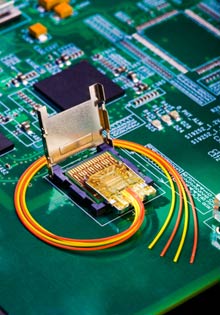 A
new "active optical cable" designed to provide ultrafast connections
between electronic devices, essentially a much faster replacement for
USB cables, is being promoted by Intel (MIT Technology Review).
Aimed at connecting PCs to peripherals like hard drives that need
faster data rates, the Intel "Light Peak" links will be rated at 10
Gb/s. Light Peak links are also designed for handling simultaneous data
streams unlike other links. Gizmodo
reports that the "early 2010" launch of the links may be in Apple
computers using links produced by Taiwanese Foci Fiber Optic
Communication. Apple and Intel have cooperated before on PC links,
namely USB, so it the rumor is true, your MAC may soon be "lighter." A
new "active optical cable" designed to provide ultrafast connections
between electronic devices, essentially a much faster replacement for
USB cables, is being promoted by Intel (MIT Technology Review).
Aimed at connecting PCs to peripherals like hard drives that need
faster data rates, the Intel "Light Peak" links will be rated at 10
Gb/s. Light Peak links are also designed for handling simultaneous data
streams unlike other links. Gizmodo
reports that the "early 2010" launch of the links may be in Apple
computers using links produced by Taiwanese Foci Fiber Optic
Communication. Apple and Intel have cooperated before on PC links,
namely USB, so it the rumor is true, your MAC may soon be "lighter." What Does "Faster" Mean? One press release on the Intel "Light Peak" links (above) stated "There's a reason that the Internet backbone is made of fiber-optic cables: photons transport bits of information faster than electrons." One reader took offense to that, saying that in fact, photons (or light waves) travel slower than electrons in certain types of cables. There is some truth in that. The average index of refraction of optical fiber is ~1.4, making the velocity of light in the glass 0.7C (70% of the speed of light,) comparable to the velocity of electrons in UTP cable. But electrons in coax can travel as fast as 0.9C, meaning they would beat photons in a race, as long as the distance was short! (very short!) But when we hear fiber is "faster" than copper, we interpret that to mean that if we have a billion bits of information to transmit, fiber can transmit all of them faster than copper, say at 40-100 GB/s over 12,000 km (and maybe 160 channels at different wavelengths on the same fiber as was recently done over an installed submarine cable.). Let's see, how many copper pairs and how many repeaters and how many megawatts of power would it take to equal that? And what the press release said was fiber transmits bits faster than copper, which is really bandwidth-related, not velocity related. "Barnraising" Broadband In the past, when America was a rural/agrarian community, neighbors would cooperate to build new barns for those who needed them. While any individual family might not be able to build (or afford to have built) a barn themselves, a community could gather for a few days and make it happen. Something very similar to barnraising is happening in parts of the country. Towns, school systems, helathcare facilities, public service organizations, etc. are getting together and finding that while no one of them could create a broadband network - or afford it - a large group working together could do it - especially with Broadband Technology Opportunities Program stimulus money! Read more from Telephony Online: http://telephonyonline.com/connectedplanet/news/broadband_scarcity_stimulus/index.html and http://telephonyonline.com/commentary/turnkey-community-fiber-1012/ Fiber Optics - Used for everything including the kitchen sink! 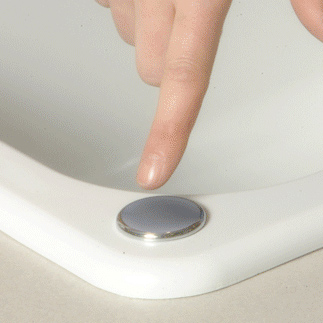 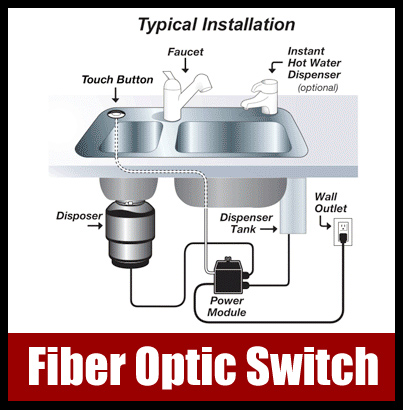 A FOA member called us recently to tell us he was installing fiber optics for garbage disposals and hot tubs, and we of course thought he was joking. But no, he was serious. Fiber optic switches using POF are being used in areas where electrical power can be a hazard, much as fiber optic lighting is used around swimming pools. In this case, it not only provides safety, but also convenience and looks. It means the garbage disposal switch can be installed on the rim of the sink and the disposal operated with the push of a finger. More- New FOA Book Available from Amazon.com for only $24.95. 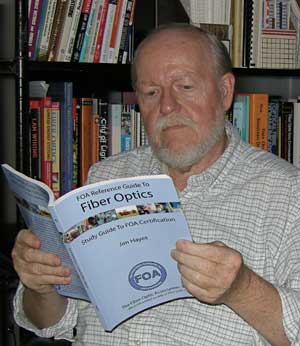 That's FOA President Jim Hayes, the guy behind the new book, reading a copy. The new FOA book, the FOA Reference Guide To Fiber Optics, is finished and available from Amazon.com for only $24.95. The new book is intended to be used in training for FOA certification and as a reference book for everybody interested in fiber optics: contractors, installers and end users of fiber optics. It's complemented by our Reference Website and complete curriculum materials for teaching fiber optic courses. This book, which benefits from 12 years of experience with our previous book, The Fiber Optic Technicians Manual, is more comprehensive on many important topics and better organized for use both as a reference and as a textbook. It's developed from our Reference Website which complements the book and covers many subjects in greater depth. And since we are self-publishing the book using more modern "publish on demand" technology, it will be easier to keep up to date and much cheaper - as you can see from the price! The FOA Reference Guide To Fiber Optics and The FOA Online Fiber Optic Reference Guide will be the official reference for the 2010 CFOT exams. Here is more information on the FOA Reference Guide To Fiber Optics. Order from Amazon.com for only $24.95. FOA Online Fiber Optic Reference Guide The FOA Online Fiber Optic Reference Guide has become very popular - perhaps the most popular technical website ever, typically with over 30,000 users monthly! We continue updating materials regularly, keeping it as up to date as possible. Wanted: Links To Technical Materials Next, we're soliciting links from fiber optic manufacturers and other organizations that have created technical materials that would be of interest to our readers. If you have technical websites you want to share, go here for our guidelines for submission. FOA Offers "Google Custom Search to Tech Topics and Online Fiber Optic Reference Guide  There's so much information on the FOA Tech Topics and Online Fiber Optic Reference Guide
that even a well-organized Table of Contents isn't enough and when the
material is always changing, an index is impossible to maintain. So the
FOA is using the latest technology in search, Google Custom Search,
which will allow you to search just the FOA Tech Topics and Online Fiber Optic Reference Guide for any topic you want to find more about. Try it! There's so much information on the FOA Tech Topics and Online Fiber Optic Reference Guide
that even a well-organized Table of Contents isn't enough and when the
material is always changing, an index is impossible to maintain. So the
FOA is using the latest technology in search, Google Custom Search,
which will allow you to search just the FOA Tech Topics and Online Fiber Optic Reference Guide for any topic you want to find more about. Try it! Go to The FOA Online Fiber Optic Reference Guide. Featured Schools: The FOA welcomes new schools receiving FOA Approval this month:
Find a listing of all the FOA-Approved schools here. Good Question! Tech Questions Worth Repeating Free-Space Optical Q: We are connecting two buildings which are about 15 KM apart.We cannot lay fiber cable under ground due to government regulations. On microwave we can only get 100Mbps. I am pondering the use of optical over the air. Kindly advise if this would be appropriate for this link. A: Typically, line of sight optical systems are limited to about 2 km distance but can be repeated for longer distances. They are susceptible to interruption by fog, rain, even birds flying through the line of sight, so may not be appropriate for your application. Testing GI POF Q: What would you suggest to test this fiber? It is POF fiber but the data sheet talks about 850 and 1300 nm. (The fiber is Chromis GigaPOF-62LD, a graded-index POF with a 62.5 micron core.) A: The specs are at 850 and 1300 nm and the core diameter is same as OM1 so a regular test kit is appropriate. They talk about ease of connection but not what losses to expect, so either a regular TIA FOTP-171 or OFSTP-14 can be used. Replacing Fiber Optic Test Equipment Q: Are you aware of any "white" paper on shelf life and replacement cycle for FO test and measurement equipment like OTDRs and Fusion splicers ? This is to get some idea on how often we should budget to replacement them, basedon typical usage for a 100 mile fiber plant. A: Generally test equipment is recalibrated regularly and as long as it continues to provide reliable measurements, it continues to be used. We used to build test equipment and we had a customer who had been using one of our testers for over 20 years! I know a cable company that still uses a 20+ year old Tektronix OF150 OTDR from the mid-1980s in their labs. I'd say the only reason test equipment is replaced is either when it's damaged or needs repair and the cost approaches the cost of new equipment or when new technology makes the new equipment better. For fusion splicers, they need regular maintenance, replacing electrodes and cleaning. Newer units are more automated and maybe more consistent, but lots of older units are being used daily. Estimating Fiber Installs Q: Currently my Utility District is in the process of designing and bidding out the installation of 51 miles of fiber cable and I am trying to find information on creating a cost estimate for this work. Would you have any information on average installation costs for various parts of the country? A: The FOA a tutorial on estimating on our "Tech Topics" website (http://www.thefoa.org/tech/estimate.htm) and the table below has some labor units that may prove helpful. I would also suggest talking to the cable manufacturers to see what they say, as they have the most experience with their products. Design/Build GPON FTTH Q: I was wondering if you knew of anywhere or any site for a guide to building a GPON network from the ground up in a county? A: We do not know of a specific site, but the FOA has lots of info on FTTH (http://www.thefoa.org/FTTX/index.html) as does the FTTH Council ( http://www.ftthcouncil.org/ ) which has published a primer on FTTH by Steve Ross (FTTH Primer: http://www.broadbandproperties.com/2007issues/feb07issues/ftthprimer_feb.pdf) Submarine Cable Q: How deep under water can a fibre optic cable go? In other words how much pressure can a fibre optic cable stand before failing? Can it go down 200m? A: It all depends on the cable. You can get cable that will go thousands of meters deep. It looks like wire rope and has fibers inside a laser-welded stainless tube. Not only is it used for undersea communications, it's used for tethered vehicles for undersea exploration FOA NL 06/06. Fiber Optic Lighting Q: I am interested in finding an optical fiber that illuminates along its length. A:It's called "edge-emitting fiber" and is shown in the FOA tutorial on lighting. http://www.thefoa.org/tech/lighting/lighting.html. Loss Budgets (A question we get all the time!) Q: Why do we count the connectors on each end of the link that will plug into our equipment as one connector alone has "no loss"? If you could shed some light on this subject it would be greatly appreciated. A: We count the connections on each end for several reasons. 1) When we test the cable plant per OFSTP-14, we use launch and receive reference cables which will include the end connections in the tests. Without including them in the loss budget, we would reject many cable plants because the tested value will be higher by two connections. 2) Network standards include the connectors on the ends since most installed cable plants are from wall or rack connection outlets to another wall or rack connection. When equipment is attached, it will be done by patchcords which will have a loss when connected to the outlet. Adding them into the loss budget therefore matches the usage. Measurement Uncertainty: Everyone testing fiber optics should understand that every measurement has some uncertainty - whether you are measuring loss, length, wavelength, power, etc. Knowing that uncertainty is very important to interpreting the measurement. It's worthwhile to read and understand the issue of measurement accuracy covered in this page of the FOA Online Fiber Optic Reference Guide. Worth Reading: WebConference: OM4 Fiber: The Next Generation of Multimode Fiber, sponsored by TIA Fiber Optic LAN Section. While 40- and 100-Gbit/sec speeds are still in the future for many companies, there are compelling reasons to consider installing this type of fiber today. Register here. Sufficiently Advanced Technology Is Indistinguishable From Magic Department: "Time Lens" Speeds Up Fiber Data Researchers at Cornell University have developed a simple silicon device for speeding up optical data. The device incorporates a silicon chip called a "time lens," lengths of optical fiber, and a laser. It splits up a data stream encoded at 10 gigabits per second, puts it back together, and outputs the same data at 270 gigabits per second. Speeding up optical data transmission usually requires a lot of energy and bulky, expensive optics. The new system is energy efficient and is integrated on a compact silicon chip. It could be used to move vast quantities of data at fast speeds over the Internet or on optical chips inside computers. (MIT Technology Review) Dirt! As much as 70% of the problems associated with deploying fiber to the home result from something as simple as dirty connectors according to JDSU. Telephony Online. What Do 5 Million Windows Computers Have in Common? They are "zombies" under the control of the Conficker virus. The sheer number of affected computers makes them probablt the greatest computing power on the planet, yet no one knows what the purpose of this entity really is. Conficker authors had begun distributing software that tricks Internet users into buying fake antivirus software with their credit cards. If you use a Windows computer, read this fron the NYTimes. Tanks And Ships GB Ethernet and fiber Upgrades. GE Fanuc Intelligent Platforms got a contract to supply a custom version of its Gigabit Ethernet switch to rumble around inside the US Army's Abrams tank. The US Navy recently awarded Boeing contract to upgrade and support the Gigabit Ethernet networks it is building on its guided missile destroyers. From Network World. Good Technical Websites American Polywater (http://www.polywater.com/) has one of the best technical website for cable installers. Here is a rundown on some new material on their site. Cable Installation using "Push" or "Push/Pull" Polywater's new Pull-Planner™ 3000 Software allows a "pushing force" variable in pulling tension calculations. Read a White Paper that quantifies the push contribution and compares calculation results to field experience. -- http://www.polywater.com/pushing.pdf Pulling Cable Through Water? Read a Product Spotlight on Polywater® + Silicone™, Polywater's new generation underground lubricant. Continued reduction of friction when pulling through water is only one of the unique features of this lubricant. -- http://www.polywater.com/NNNBSL.pdf Check out their website, especially “Videos,” “Engineer’s Corner” and “Calculators.” http://www.polywater.com/NNNBSL.pdf  " Heard on the Street" is a monthly online newsletter from Frank Bisbee of Communications Planning Corporation that covers the telecommunications and cabling businesses. Each month includes news from manufacturers, trade associations and professional societies like the FOA. You can read the current issue and back issues online.  JDSU has announced the See the Light webinar series, a four-part program designed for anyone involved in the installation, maintenance, and repair of fiber optic systems. It begins with fiber inspection and cleaning and then covers the basics of fiber testing. The webinar series then continues with the more advanced optical time-domain reflectometer (OTDR) and fiber local area network (LAN) testing challenges. More information on the series. IGI is offering a series of webinars on topics of interest to those in the communications industry. You can join them live ir download from the archives. IGI WEBINAR ARCHIVES UP AND RUNNING - VISIT TELECOMBRIEFINGS.COM TO DOWNLOAD! IGI, a major market research and technology reporting company (the "Active Optical Cables" below) is offering a a free one year subscription to one of our fiber optics newsletters to FOA members. All they have to do is to send IGI an e-mail stating which newsletter they would like to get. See http://www.igigroup.com/nl.html for a listing of IGI Newsletters. The new FOA reference website is now online. New sections have been added on fusion splicing and mechanical splicing. Check out the current Table of Contents. Coming soon to a network near you - 40 and 100 gigabit/sec Ethernet! The IEEE is already working on specs for 40 and 100 gigabit/sec Ethernet and have approved a number of new PMDs (that's standards-speak for Physical Medium Dependent - i.e. cabling). A summary of the proposals is on the updated list of network specs at http://www.thefoa.org/tech/Linkspec.htm.
"Chutes" For Blowing Lines Through Conduit 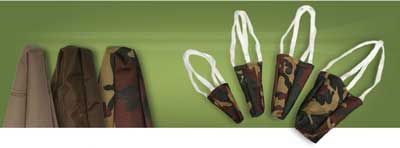
Used Test Equipment – Buy or Sell http://www.testequipmentconnection.com/ Have you read the FOA Tech Topics on Cleaning? More links on cleaning: Cleantex Alco Pads Fiber-to-the-Home Council: North American Fiber to the Home Connections Surge Past Five Million FTTH Networks Now Available to 15 Percent of Homes HOUSTON, Sept. 29, 2009 - The number of North American fiber to the home (FTTH) subscribers now stands at more than 5.3 million, as deployers of end-to-end fiber networks continue to add more than 1.5 million customers a year, according to a study released today by the Fiber-to-the-Home Council. The study, which was conducted by RVA Market Research (www.rvallc.com) and will be presented tomorrow to the 2009 FTTH Conference & Expo in Houston, also found continued robust growth in the number of homes passed by FTTH networks, which rose to 17.2 million from 13.8 million a year ago. Five years after their deployment began in earnest, fiber to the home networks are now available to 15 percent of homes in North America. "The march to all-fiber networks is showing no sign of letting up in the United States and Canada," said Joe Savage, President of the FTTH Council, which promotes and tracks the growth of fiber to the home in North America. "Given the growing sophistication and bandwidth requirements of online and video applications, as well as the high satisfaction that current FTTH subscribers are expressing about their fiber service, the growing consumer demand for end-to-end fiber is now a fact of life and something that our members are working hard to satisfy." In addition to the 5.33 million homes connected to FTTH, the study found that the overall "take rate" - the percentage of those offered FTTH service who decide to subscribe - went up for the seventh straight six-month period, with the vast majority of providers experiencing take rates of greater than 50 percent. Download the accompanying charts on FTTH deployment. Led by Verizon's massive investment in FTTH technology in the deployment of its FiOS service, the fiber to the home industry in North America also includes hundreds of smaller telephone companies and other network providers, municipalities, planned residential communities and cable television companies that are making the move to end-to-end fiber to deliver next-generation video, internet and voice services. Given the almost unlimited bandwidth of fiber, FTTH technology is seen as an ideal way of "future-proofing" networks in light of the ever increasing consumer and business demand for faster networks and higher-bandwidth applications. David Chaffee's FTTH Prism Newsletter is Online (archives are at bottom of the linked page) Verizon Ups FiOS Speeds in NY Verizon is offering faster FiOS speeds in NY and even getting into the TV biz with a local channel. Telephony. In Norway, You Might Have To Bury Your Own Cable To Get FTTH! A Norwegian triple-play provider has a unique solution to the pesky problem of digging up consumers' yards to bury fiber-to-the-home. Lyse Tele, an overbuilder that launched its fiber-based all-IP solution in 2002, installs the fiber right to the edge of a customer's lawn, then gives the customer instructions on how to bury their own fiber cable to the house. Read More From Telephony.
|
What Is The FOA? Hear FOA President Jim Hayes tell the FOA Story in a 2-part interview by Sound & Video Contractor Contributing Editor Bennett Liles. It tells about the FOA history, goals and achievements. Part 1: http://svconline.com/podcasts/audio/fiber_optic_association_part1/index.html. Part 2 http://svconline.com/podcasts/audio/inside-fiber-optic-association2-0924/index.html. |
|
Digging Safely (Read the FOA Tech Topic) There is a new toll-free "call before you dig" number: 811 See www.call811.com for more information National Fiber Optic Protection Summit: By the "811" group. March, 2008 in Vegas.
|
|
|
Electro Mechanical Engineer, Illumination Systems (09/09) Exciting East Hartford, CT engineering firm in the fiber optics industry has the need for an out of the box thinker and design expert. You will be supporting contracts to provide lighting for naval surface ships. Work with a strong and experienced management team. Great opportunity for the right individual! Position Particulars: Degree in Electro-Mechanics or a similar discipline and 4+ years of experience related to electro-mechanical components assembly, illumination systems, and testing. Given the nature of the work, US Citizenship is required and Secret Clearance a plus. Build the fiber optic illumination system components. Test the components and systems. Assist in the expansion of the optics lab and R&D capabilities. Assist in the development and fabrication of new illuminators, lamp reflectors, luminaires, and other non-imaging devices. Assist in the characterization of the emission and performance of different light sources including metal halides and LED’s. Provide support in the development of the technical documentation and the data deliverables pertaining to the illumination systems. Assist with testing, qualification, installation, and system integration at the test facility and at the customer site (shipyard and/or US Navy vessel). Position highlights: Illumination Fiber Optic Cable Design Illuminator (Light Engine) Design for Manufacturing Light Diffuser (Luminaire) Design for Manufacturing System Testing Engineering Design Product Development Installation Support Contact: Tony Raccio tony@golden-compass.com or Debra Benton debra@golden-compass.com Splicers - Canada (7/09) My company - Telco Direct Services Inc. Is currently under contract in Vancouver and the lower mainland and I require fiber splicers for approx 3 months possibly longer term. Rate of pay will be $40-50 depending on experience. Contact: telcodirect@shaw.ca Jeff Bondon - 647-892-6901 CEO Telco Direct Services Inc. Instructor/San Diego (6/09) "Private College looking for an Instructor to teach Cabling and Fiber Optic Classes". Part and Full time positions available. Campus located in San Diego, Contact Gary at 619.234.2181, Ext. 312 Do listings in the FOA Newsletter Work? Here's feedback: "We did great! We have over 15 interviews next week." Thanks, David Swales, Jr.
|
|
Your Name, CFOT - It pays to advertise! The FOA encourages CFOTs to use the logo on their business cards, letterhead, truck or van, etc. and provides logo files on this site for that purpose. But we are also asked about how to use the CFOT or CFOS certifications. Easy, you can refer to yourself as "Your Name, CFOT" or "Your Name, CFOS/T" for example. Feel free to use the logo and designations to promote your achievements and professionalism! |
|
Remember To Renew Your Certification ! Remember
to renew your FOA certification. All current CFOTs have a ID Card with
their certification data and we keep a database of current CFOTs to
answer inquiries regarding your qualifications if needed. You must be a
current FOA member and CFOT to participate in our online
database of installers, contractors, technicians and consultants.
If you forgot to renew, use the online application
form to renew NOW! You can now renew your FOA certification online - and get an extra month free. Details here. |
|
|
|